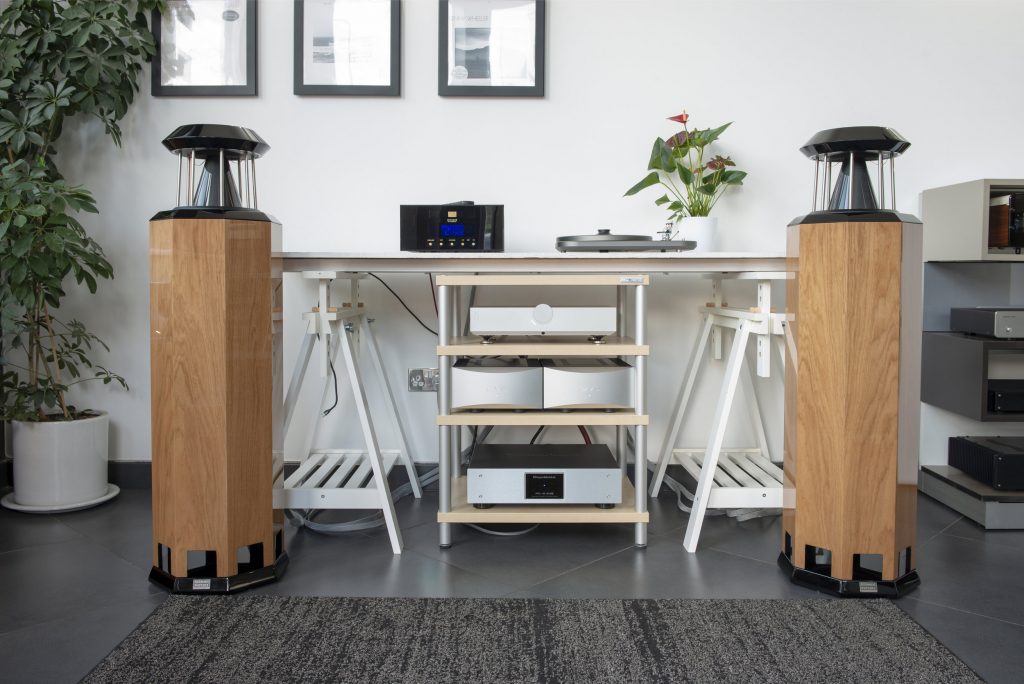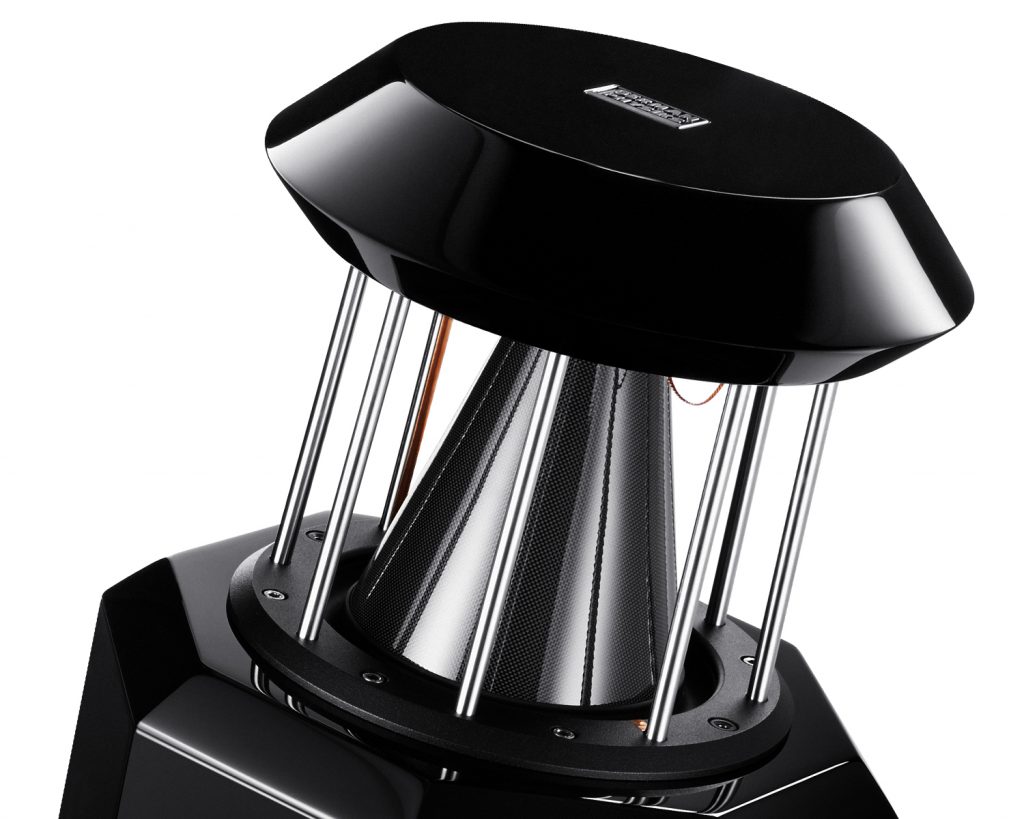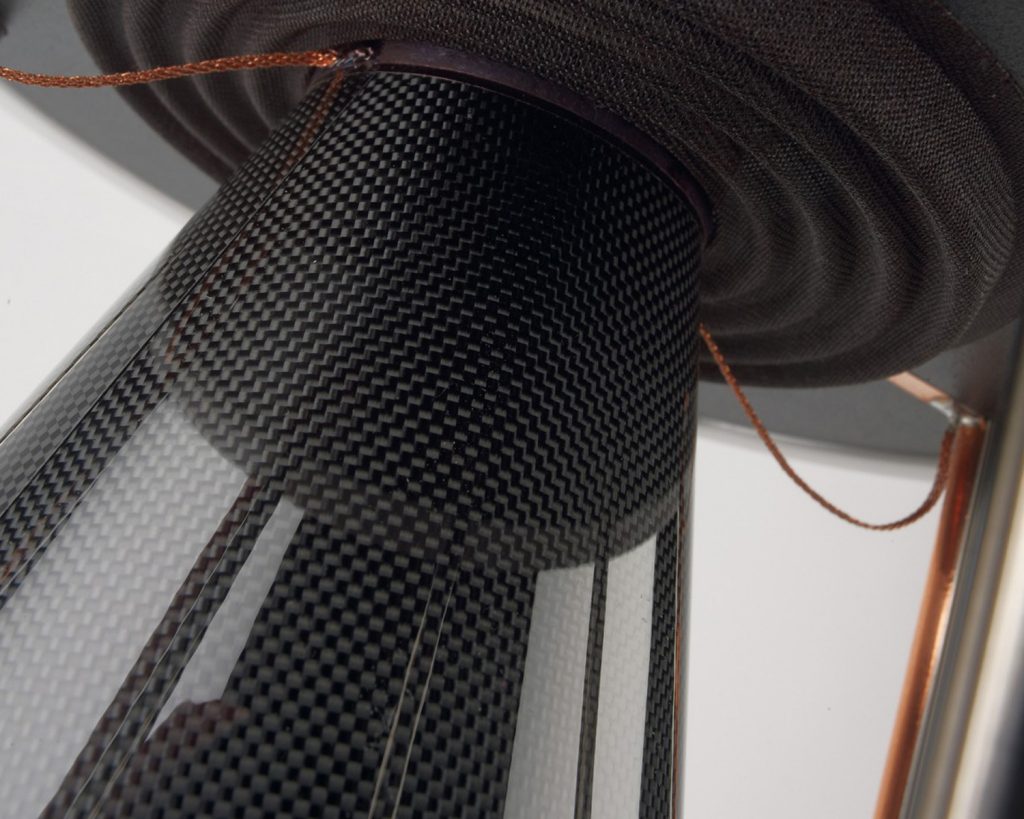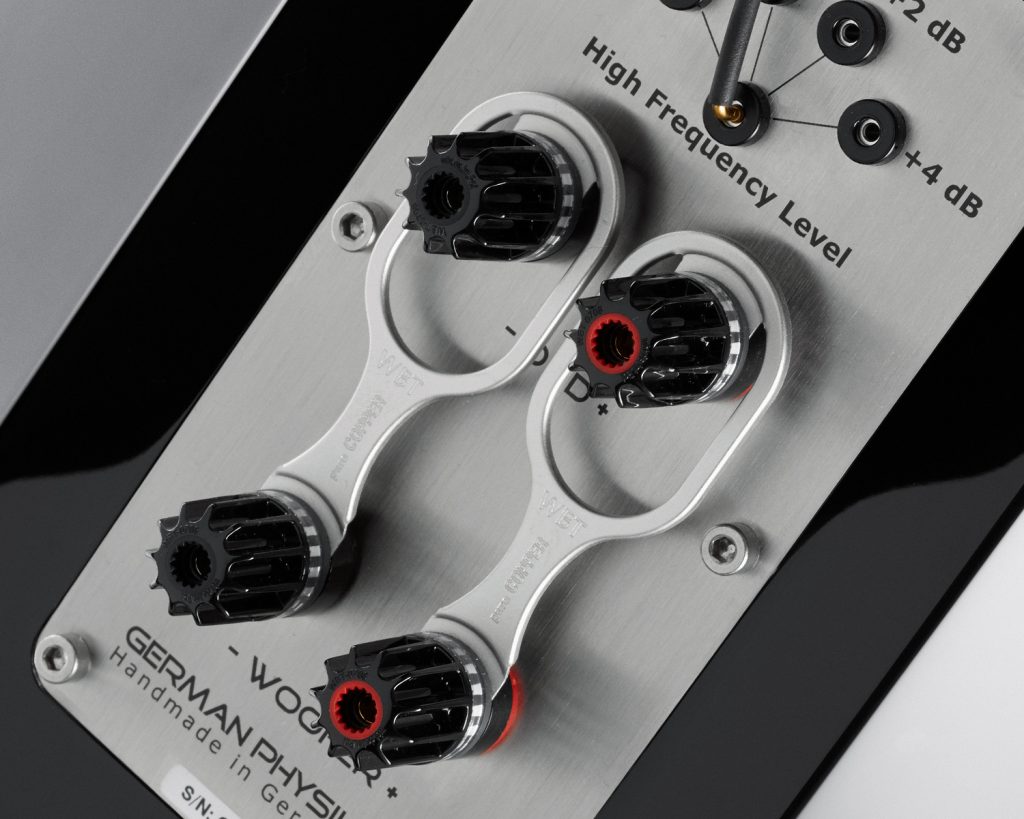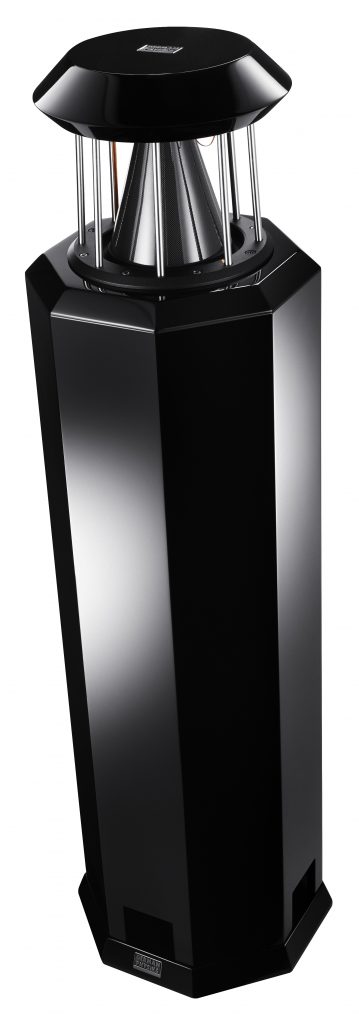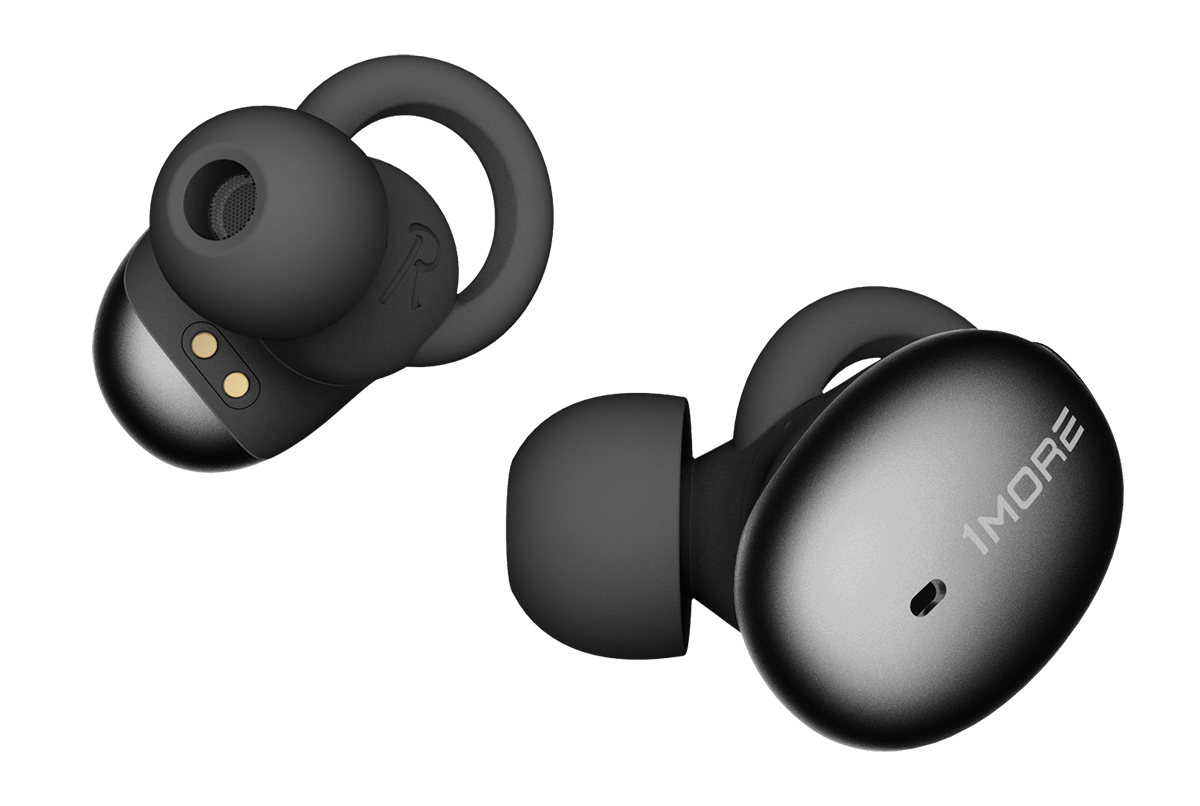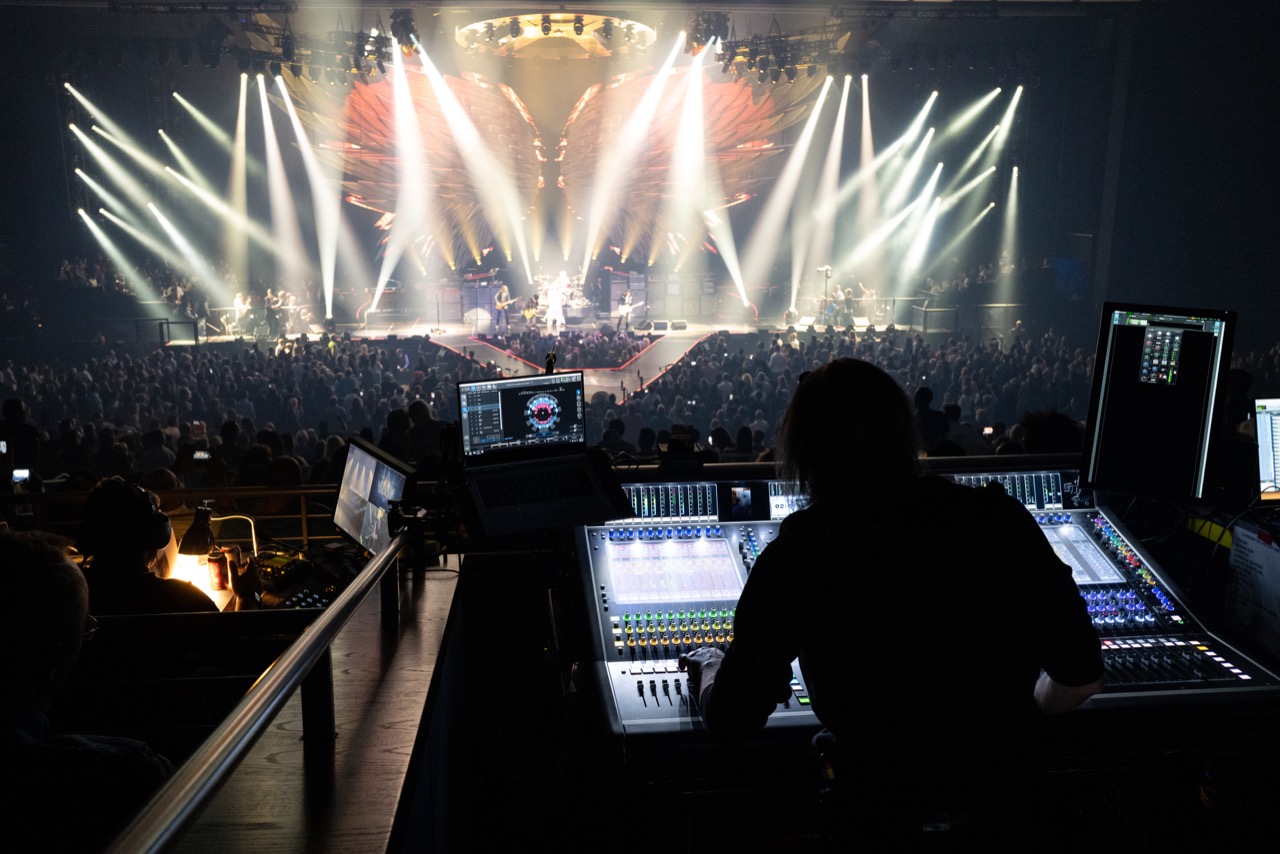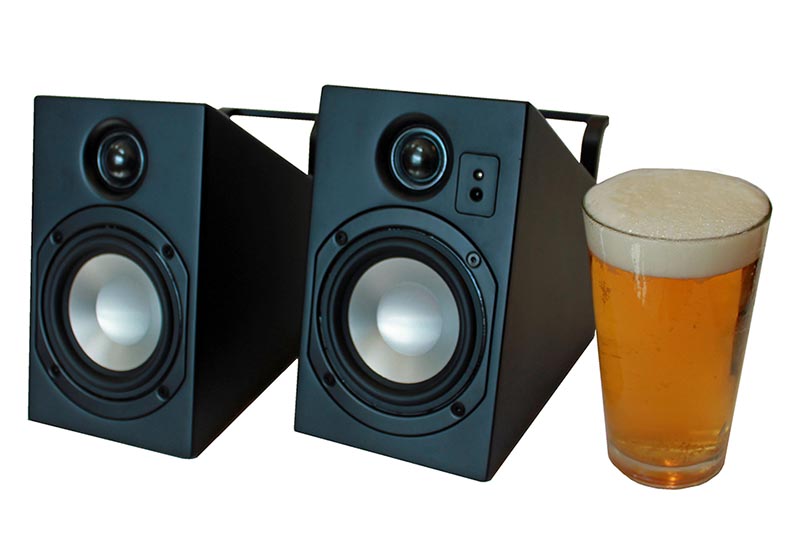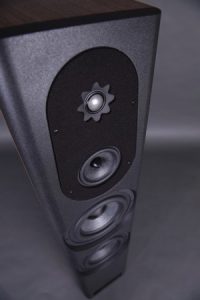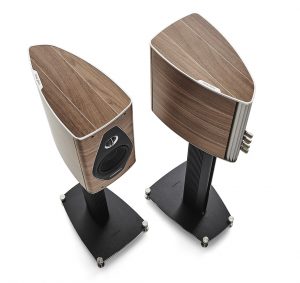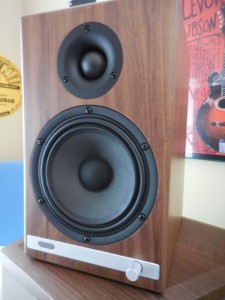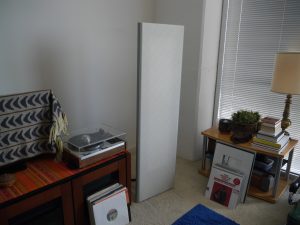One of my fondest memories as a teen was poring over the pages of the Tech Hifi catalog. Located on Route 35 in Eatontown, NJ, it was the closet thing the Jersey Shore offered to high end audio, and to me it represented the state of the art in home sound reproduction. The catalog lay out was organized around a number of systems starting with entry level in the front of the catalog, gradually building to what was touted as the NE plus ultra. The centerpiece of this glorious system was the exotic Ohm F speakers. And that, my friends, is where I set my sights. At the ripe old age of 15 I already knew I was a back of the catalog kind of guy. I expended substantial time and energy working out how I could earn enough to afford a decent mid-level system and imagining the day when, now an international rock star, I would own the ultimate system featuring SAE electronics, a Micro Seiki turntable, and those beautiful towers featuring the exalted Walsh driver.
The fact that I had never actually heard any of this gear, nor anything close for that matter, did not temper my enthusiasm one bit. The descriptions were just so compelling that I would spend hours reading and re-reading about the exquisite realism of their stereo reproduction, memorizing the specifications, and imagining how the music I so loved would come to life in ways that exceeded all expectations. Sadly it was not to be, not yet anyway.
I ended up buying a pair of Ohm C2 speakers which came with an extra large serving of bitter disappointment. I got them home and set them up with great anticipation, but in the end they didn't sound all that different from anything else I had heard in my very limited audiophile experience. I couldn't put my finger on it at the time, but in retrospect, the complete lack of imaging, coherence, and anything to differentiate the system from typical mid-fi, aside from them sounding slightly better than the JBLs to which I had compared them in the store, left me with the sense that there must be something more.
It wasn't until years later when I walked into the Stereo Exchange on Broadway in NYC, and heard Tim Hardin's "Reason to Believe" spinning on a Linn LP-12 through a pair of Dahlquist DQ-10s, that I knew beyond the shadow of a doubt that The Matrix was real. The experience had been like searching for Atlantis, for years, and finally finding it, without ever having been certain of its existence.
The Ohm Fs still occupy a special place in my audiophile heart. To this day, despite decades of experience, having attended dozens of audio shows and having auditioned hundreds, maybe thousands of pairs of loudspeakers, I have yet to hear them. Yet I have it on faith, they are something different, something distinct, something unique in the world of audio.
Patented in 1969, the "Coherent Wave Transmission Line Driver," or Walsh driver, was invented by the late Lincoln Walsh. It consisted of an elongated, single cone, firing downward into a speaker cabinet. This single driver produced coherent sound, radiating what is essentially the driver's back wave, in a 360 degree pattern, and operated full range from 20Hz to 20kHz. Because it operated full range with no crossover, this arrangement was free of the time and phase distortions common to other multi-way dynamic driver designs.
Unfortunately, the original Ohm F was notoriously difficult to drive, and just as easy to destroy. Ohm's current president, John Strohbeen joked, "They needed 300 watts to get going and 301 watts to blow them up." Ohm couldn't repair them, so they replaced the blown drivers under warranty. Eventually the reliability problems were resolved, and the Ohm Fs remained in production for 12 years. To their credit, Ohm still manufactures Walsh driver based speakers, and still offers factory upgrades to the Fs and many other speakers from their Brooklyn facility. (Coincidentally, John Strohbeen co-founded Tech Hifi with partner Sandy Ruby in his dorm room at M.I.T. before taking over Ohm.)
In 1978, Peter Dicks, mathematician, engineer, and sociologist, had become fascinated with fundamental problems of audio transducer behavior. Building upon the work of Lincoln Walsh, and employing extensive mathematical modeling and materials research, Dicks fully realized the potential of the Walsh driver in what would become known as the Dicks Dipole Driver or DDD. Available in either a titanium or carbon fiber cone, a single driver is capable of covering the range between 120Hz to 21.5kHz or 70Hz to 24kHz, respectively though they are typically crossed over to a more conventional woofer at a slightly higher frequency.
And though there are substantial differences between the Walsh driver and the DDD driver, the differences lie not so much in the the underlying idea, but in Dicks' passionate pursuit of perfection, impeccable execution, and maximizing every aspect of performance and potential, taking the idea to its fullest expression. Despite the fact that it is very simple looking, the devil is in the details. The extraordinary performance of the DDD is dependent on extensive research and experimentation to determine the exact cone angle, material thickness, orientation, and probably hundreds of other small details that comprise the finished product.
That brings me to the German Physiks HRS-130s. Upon first glance, the single carbon DDD bears more than a passing resemblance to the Walsh driver, placed atop the cabinet and firing downward into the enclosure like an inverted ice cream cone. An actuator sits where you would typically find the voice coil, and the open end is terminated by a rubber suspension that is semi-rigidly attached to the driver chassis. And whereas the goal of typical driver design is to be as light and rigid as possible, the DDD driver is constructed of a light and very flexible foil, in this case 0.15mm thick carbon fiber. (The foil in the titanium DDD is 0.025mm thick.)
In the HRS-130 a single DDD driver covers the frequency range from 24kHz down to 220Hz where it crosses over at 12dB/octave electronic, 18dB/octave acoustic, to a 10" driver which then takes the system down to 29Hz. And while there are other systems that employ a full, or nearly full range driver, what sets this system apart is the unusual way in which the driver operates. It operates in four different modes, depending upon which frequencies are being reproduced; as a Small/Thiele resonator in the lowest frequencies, transitioning to pistonic mode as the frequency rises where the entire cone moves as a whole, gradually overlapping and transitioning to a bending wave with this mode covering the majority of its operating range, then finally to modal radiation at the dipole frequency when the first standing wave occurs and modal break-up begins. In the bending wave and modal modes the wave originates at the top of the cone and travels downward along the cone until it is absorbed by the surround. Sound is radiated outward in a 360 degree pattern, perpendicular to the direction of the signal. The technology behind the driver is quite fascinating, and for a more detailed look I encourage you to explore the German Physiks website at www.german-physiks.com.
The 10" bass driver integrates well with the rest of the system, providing a visceral, well resolved, and satisfying bottom end. The cabinet is octagonal, allowing each panel to be smaller and stiffer than you would find on a typical square section cabinet. The speakers come standard in either white or black, high gloss, polyester finish. Additional finishes are available through special order. Two pairs of WBT speaker terminals allow for bi-wiring or bi-amping with included jumpers for use with single wire cables. Jumpers on the rear panel allow you to tailor the high frequency response to the absorption characteristic of the room in four increments, -2dB, flat, +2dB, and +4dB.
Due to the omnidirectional nature of the drivers I could just place them where the bass sounded the best and ignore typical concerns, like toe in, primary and secondary reflections, etc. A pair of Merrill Veritas amplifiers drove the speaker with power, delicacy, and authority and contributed in no small way to what I was about to experience.
Technology and uniqueness aside, the question always comes down to how do they sound. I can say unequivocally, they are different from what you are used to, and to my mind, represent a better approach to sound reproduction. Typical box speakers, no matter how well designed and executed, operate within a certain paradigm and are, by definition, limited by what that paradigm makes possible. The HRS-130s operate within a different paradigm, therefore producing a different result. In other words, you can make the best internal combustion money can buy, perfect ever aspect of its design and execution, and as much as you can push the technological bounds of that technology, it will never be a jet.
What that means in listening terms is that HRS-130s produce a more cohesive, natural sounding soundstage in which all of the musicians are of a piece, well defined, well resolved, but as a more organic whole. The overall effect was more lifelike, and most importantly, more engaging and relaxing. They are the first speakers that have made me seriously consider trading in my Wilson-Benesch A.C.T.s for something else, as beautiful and beloved as the WBs are.
While the nature and quality of their imaging is the most unique and distinguishing feature, they also excel in every other aspect of sound reproduction, tonal accuracy, full range response, dynamic range, resolution of detail, macro and micro dynamic response, and most likely owing to its unconventional design, phase response. This last aspect, phase response, is possibly one of the least understood and least appreciated aspects of speaker design, while having one of the greatest impacts on the sound coming from a pair of speakers. The ability to focus an image and create a cohesive sense of timing and rhythm is largely dependent on phase response and by definition, a full range or nearly full range speaker is free of the phase response errors that plague most multi-way loudspeakers. It is this phase accuracy, coupled with the unique omni-directional radiating pattern, that allows the HRS-130s to generate the paradigm busting imaging quality I found so seductive. The seemingly paradoxical attributes of a highly focused image in an expansive and enveloping soundstage were inherent in Walsh's original driver design, later improved upon and perfected by the incremental advancements by Dicks.
I'm forced to go beyond the typical audiophile lexicon to describe the sound of the HRS-130s, and by extension, the entire German Physiks line, they are that different. Typical speakers are the audio equivalent of an overclocked flat screen television operating at the 120Hz or 240Hz setting. (The thing Tom Cruise was just up in arms about.) While the images are sharper, they also become flatter, more cut out, more soap opera like. Overclocking adds what is not there, creating additional frames by interpolating the preceding and following frames, ostensibly to smooth out the motion strobing seen during fast camera movements or sometimes on titles.
The result is a hyper-real image that is both distracting and horrendous. Most people that I have encountered, before figuring out you can turn it off, wonder what is wrong with their brand new TV. The normal setting produces a more film-like setting, less in your face, more relaxing, allowing you to disappear into the story and forget what's producing it. The HRS-130s are like cinema, no less resolving or focused than more traditional loudspeakers, but they allow you to disappear into the music and forget what's producing it.
Listening to Nils Lofgren's "Keith Don't Go" from Acoustic Live (CD, Vision Music, Inc VMCD 1005), the HRS-130s were a little drier than my A.C.T. speakers, but not in an analytical way. They seemed to exert more control over the signal, creating a more precise and detailed rendition of the music while at the same time, and paradoxically, producing a more lush, expansive, three dimensional, and enveloping performance. I found the effect completely engaging, inviting me in to listen to the music, not pushing it on me as with typical dynamic speakers. In short, more like the real thing. Their combination of detail and fullness reminded me of the YG Acoustics Anat Reference II's I reviewed a few years back while the imaging created by the DDD driver was nothing like them.
"Jazz Variants" from The O-Zone Percussion Group's La Bamba (CD, Klavier K 77017) is an incredibly dynamic recording, and a torture test for most speakers. Though I don't know what their ultimate dynamic capability is, in my moderately sized room, the HRS-130s were very impactful, never showing any signs of strain or compression. Inner detail was well resolved, I could easily pick out the second head tuning of the marching toms as well as the vibrato of the vibraphone, neither of which I had ever heard before on this recording.
The sound of the stick on the high hat on "Just A Little Lovin'" from Shelby Lynne's wonderful Just A Little Lovin' (CD, Lost Highway 0602517448254) illustrated the nuanced differences between the HRS-130s and most dynamic speakers exceptionally well. On both sets of speakers, the placement of the high hat was precise and had the right timbre, the sound tightly focused with the ping of the stick strike distinct from the metallic ringing of the cymbals. On the German Physiks speakers I could locate the edges of the high hat, the size; I had a sense of context, that the high hat had come to life in a particular space and wasn't just thrust naked into my listening room.
Overall the sound was very transparent and delicate, with lots of air, revealing of low level details. The electric bass was well defined and impactful, its visceral growl adding a nice contrast to Lynne's soulful lyrics. She was a bit more diffuse, more realistic on the 130s compared to the Wilson-Benesch speakers with the micro-dynamic ability of the DDD drivers allowing for very subtle shading to the music. Some might initially prefer the slightly more focused vocal presentation offered by traditional dynamic speakers but comparatively speaking, that in your face quality became tiring after a time while the 130s invited me to listen for hours on end.
Like all highly resolving speakers, the HRS-130s are revealing of what is upstream whether it be the source material or the equipment. The individual voices of Ladysmith Black Mambazo were well separated on Paul Simon's, "Diamonds on the Soles of her Shoes," Graceland (CD Warner Brothers W2-25447), while Simon's voice came across as a bit analytical, an artifact of the early digital era during which this album was recorded.
To say I love these speakers would be an understatement. Unlike the Ohm C2s of my youth, the HRS-130s not only did not disappoint, but they exceeded all expectations and surprised me with their unique and lifelike presentation of the music. Between their tonal accuracy and range, bass slam, micro and macro dynamic capability and exquisite imaging capability, the HRS-130s are a must audition if you are shopping for speakers in this price range. They are in fact my new favorite speakers in the under $25,000 range. And if you are just curious about what a new paradigm for stereo reproduction sounds like you should still check them out. The HRS-130s are different, very different. You owe it to yourself to have a listen.
Specifications
- Impedance: 4 ohms
- Frequency Response: 29 - 24,000Hz
- Power Handling: Nominal 120W
Short term 200W - Amplification Required: Minimum 70W/4 ohm
- Crossover Frequency: 220Hz
- Crossover Slopes: DDD section 12dB/octave electronic & 18dB/octave acoustic
- Woofer section 12dB/octave electronic & 18dB / octave acoustic
- High Frequency Adjustment: -2dB, flat, +2dB and +4dB
- Sensitivity: 86.9 dB for 1W at 1m
- Operating Principle: 2-way loudspeaker with 360° surround radiation
using the German Physiks DDD drive - Input Connectors: 2 sets of WBT nextgen™ binding posts
- Drivers: 1 x carbon fibre DDD driver
1 x 10-inch woofer - Recommended Room Size: 10—75 square metres
106—792 square feet - Finish: Standard: High polish polyester black or white, carbon fibre
- Special order: Satin or high polish veneer / Satin or high polish paint
- Dimensions: 325mm W x 1,259mm H x 325mm D
12.8" W x 49.6" H x 12.8" D - Weight: 34.5kg / 75.9lbs
- Warranty: 5 years
HRS-130 Loudspeakers
Retail: $22,000 (satin veneer or paint); $24,500 (high polish polyester or veneer); $25,000 (carbon fiber)
DDD Manufactur GmbH
Gutenbergstrasse 4
63477 Maintal
GERMANY
+49.6109.502.98 23
US Distributor
Laurence A. Borden, Distinctive Stereo LLC
River Vale, NJ
201.391.1411




